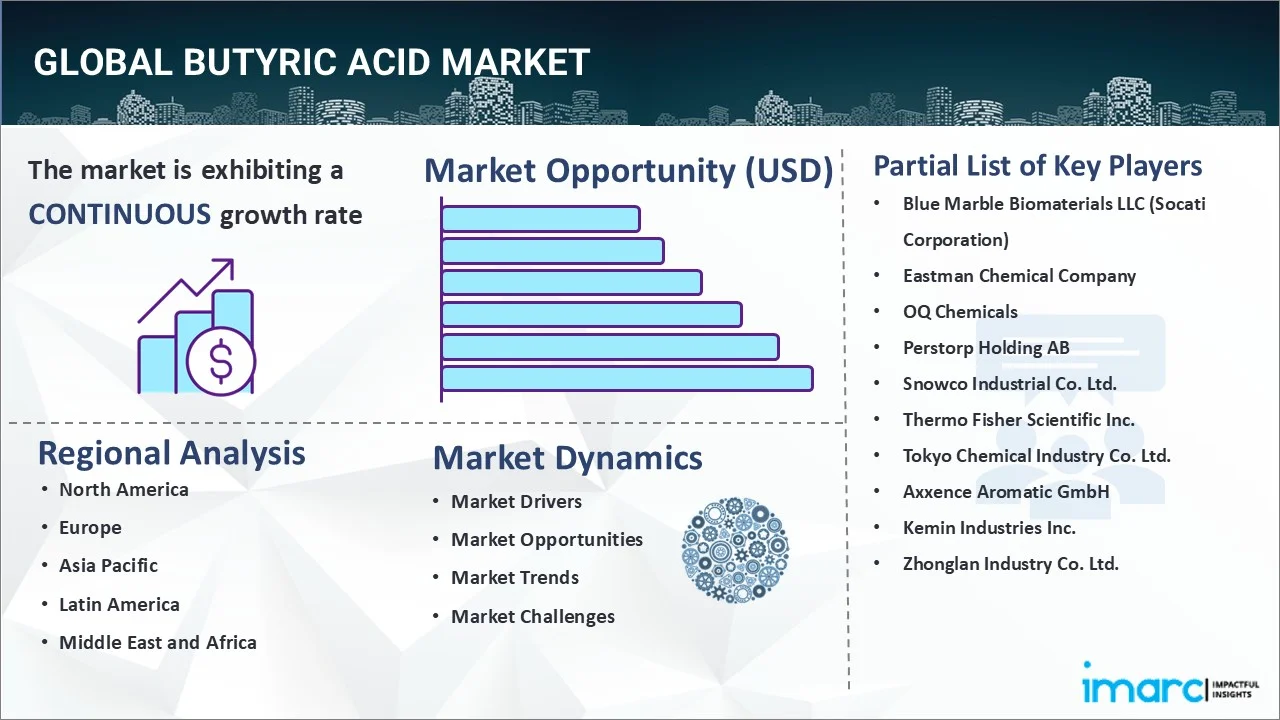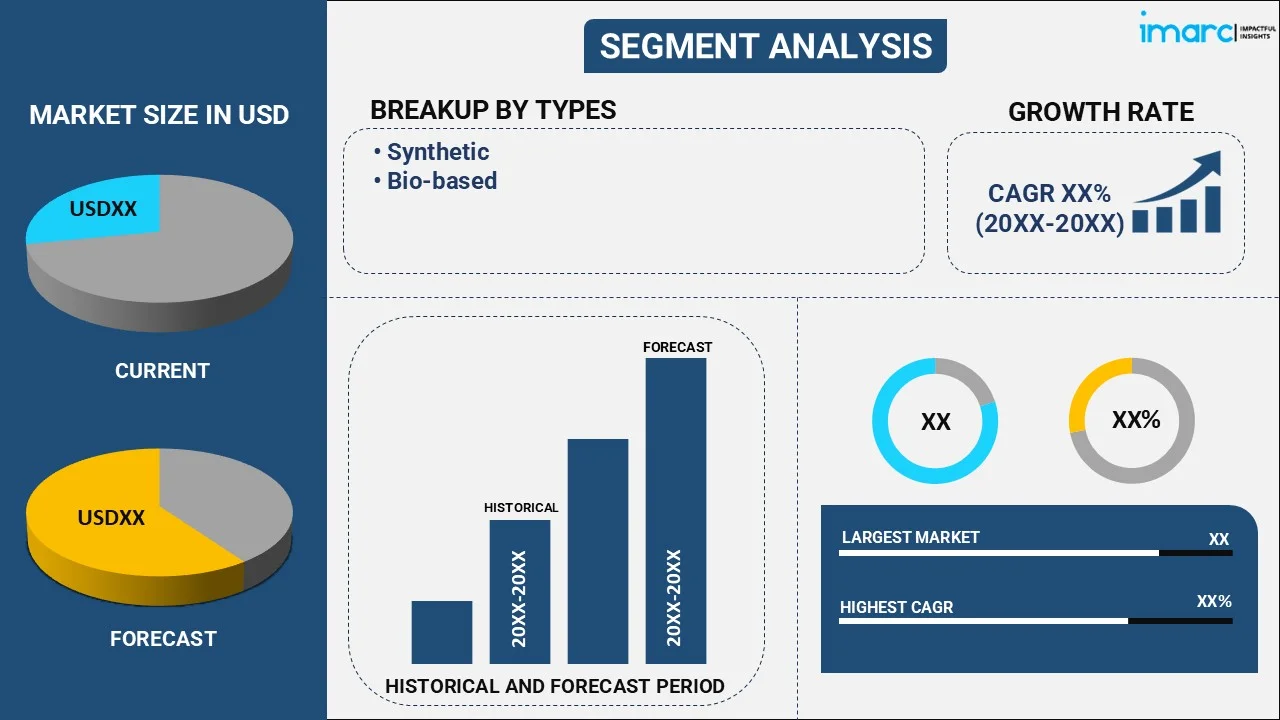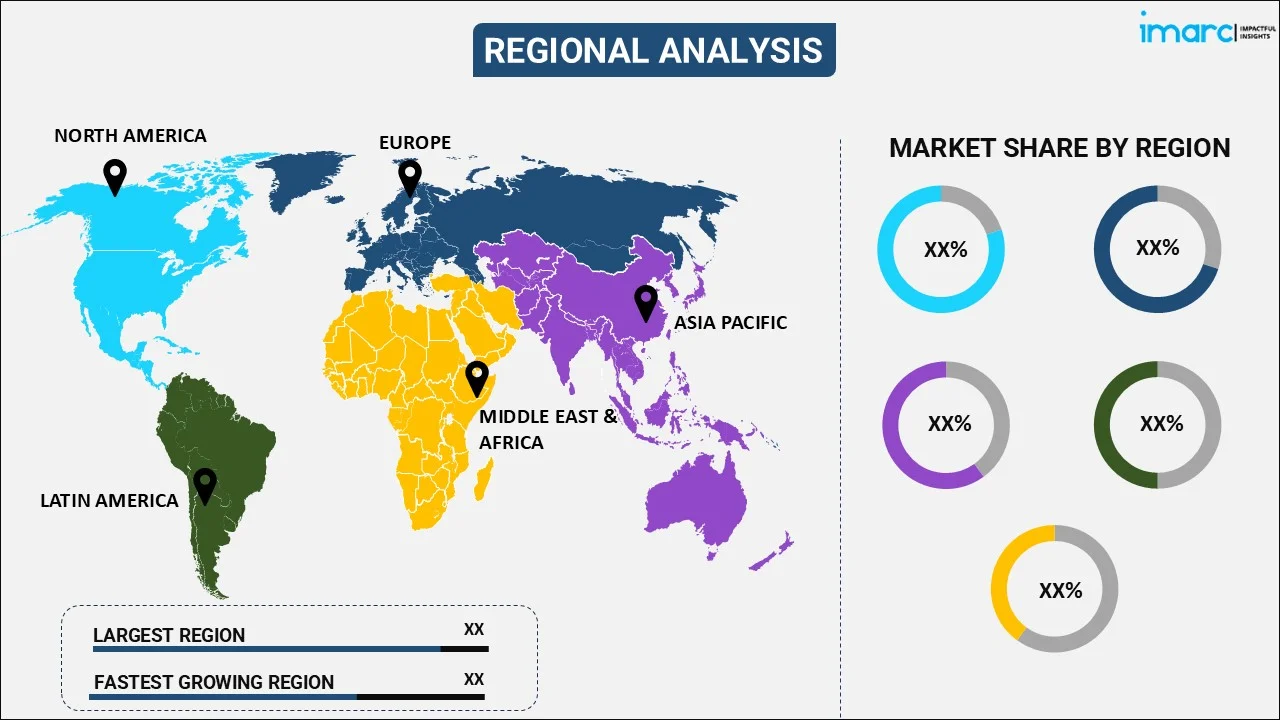
Butyric Acid Market Report by Type (Synthetic, Bio-based), Derivative (Sodium Butyrate, Calcium Butyrate, and Others), Application (Animal Feed, Chemical Intermediate, Food and Flavor, Pharmaceutical, Perfume, and Others), and Region 2025-2033
Butyric Acid Market Size Share And Trends:
The global butyric acid market size reached USD 263.5 Million in 2024. Looking forward, IMARC Group expects the market to reach USD 749.0 Million by 2033, exhibiting a growth rate (CAGR) of 11.69% during 2025-2033. The market is expanding quickly, driven by increasing product demand in the manufacturing of animal feed, rising product utilization in the pharmaceutical sector, and the expanding food and beverage (F&B) industry globally.
|
Report Attribute
|
Key Statistics
|
|---|---|
|
Base Year
|
2024
|
|
Forecast Years
|
2025-2033
|
|
Historical Years
|
2019-2024
|
|
Market Size in 2024
|
USD 263.5 Million |
|
Market Forecast in 2033
|
USD 749.0 Million |
| Market Growth Rate (2025-2033) | 11.69% |
Butyric Acid Market Analysis:
- Major Market Drivers: The increasing use of butyric acid as a feed additive in animal nutrition to enhance gut health and promote growth performance, is driving the market growth. Aside from that, increasing product application in the pharmaceutical industry, as well as developing food and beverage (F&B) industries, are driving the butyric acid market growth.
- Key Market Trends: Innovations in synthetic production technologies, which are improving cost-effectiveness and environmental sustainability, are one of the major trends in the market. Beyond this, growing consumer preference for natural and bio-based ingredients and shifting trend towards antibiotic-free meat production is fueling the market expansion.
- Geographical Trends: Asia Pacific dominates the butyric acid market due to the rapid expansion of the livestock and food and beverage industries in countries like China and India. Other regions are also witnessing increased butyric acid demand due to the expanding personal care sector and growing investment in the agriculture sector.
- Competitive Landscape: Some of the major market players in the butyric acid industry include Blue Marble Biomaterials LLC (Socati Corporation), Eastman Chemical Company, OQ Chemicals, Perstorp Holding AB, Snowco Industrial Co. Ltd., Thermo Fisher Scientific Inc., Tokyo Chemical Industry Co. Ltd., Axxence Aromatic GmbH, Kemin Industries Inc., Zhonglan Industry Co. Ltd., among many others.
- Challenges and Opportunities: According to the butyric acid market forecast, high production costs and complex manufacturing processes pose significant challenges. Beyond this, regulatory hurdles and stringent quality standards are impeding the market growth. However, the growing demand for environmentally friendly and sustainable goods is opening up new avenues for innovation in the manufacturing of butyric acid derived from biomass.

Butyric Acid Market Trends:
Increasing Demand in Animal Feed
The growing need for butyric acid in animal feed is a crucial factor boosting butyric acid market revenue. The animal feed industry is predicted to increase at a 2.9% annual rate, reaching $674.7 billion in 2032. Butyric acid, a short-chain fatty acid, is important in animal nutrition because it promotes intestinal health and increases nutrient absorption. Its inclusion in animal feed is especially useful to monogastric animals like chickens and swine, who lack the ability to create enough butyric acid in their digestive tracts. Butyric acid improves gut health, promoting a balanced microbiome, lowering the incidence of gastrointestinal illnesses, and boosting overall animal performance. This results in faster growth rates, greater feed efficiency, and higher-quality meat and dairy products. With the rising global population and increasing demand for protein-rich diets, the livestock industry is under pressure to produce more high-quality animal products efficiently. This has resulted in a greater emphasis on animal health and nutrition, propelling the use of butyric acid in feed compositions.
Rising Use in Pharmaceuticals
The rising product utilization in the pharmaceutical industry is another key factor behind butyric acid market recent opportunities. Butyric acid and its derivatives are being recognized for their therapeutic potential in a variety of health issues, including gastrointestinal disorders, inflammation, and cancer. Butyric acid has been shown in studies to have anti-inflammatory and anticarcinogenic properties, making it a promising candidate for developing new drugs and therapies. Its involvement in gut health is especially important since it acts as an energy source for colonic epithelial cells and regulates the immune response. This has led to its use in the treatment of inflammatory bowel illnesses (IBD), including Crohn's disease and ulcerative colitis. Moreover, butyric acid has shown potential in cancer therapy, particularly in inducing differentiation and apoptosis in cancer cells.
Expanding Food and Beverage (F&B) Industry
According to the latest butyric acid market outlook, the expanding F&B industry is a major driver, as this sector increasingly incorporates this chemical due to its versatile applications and health benefits. Butyric acid is used as a flavoring agent, providing a distinct taste to various food products such as cheese, butter, and yogurt. Its characteristic odor and flavor enhance the sensory qualities of these products, making them more appealing to consumers. Additionally, butyric acid is gaining popularity as a health-promoting ingredient in functional foods and dietary supplements. Its role in improving gut health, supporting immune function, and potentially aiding in weight management makes it a valuable addition to health-conscious consumer diets. Furthermore, the demand for butyric acid is expected to rise along with the F&B industry's expansion. In Europe, consumer expenditure on F&B increased by 21.5%. In addition, the European F&B sector recorded a remarkable turnover of Euro 1121 billion in 2022.
Butyric Acid Market Segmentation:
IMARC Group provides an analysis of the key trends in each segment of the market, along with forecasts at the global, regional, and country levels for 2025-2033. Our report has categorized the market based on type, derivative, and application.
Breakup by Type:

- Synthetic
- Bio-based
Synthetic accounts for the majority of the market share
The report has provided a detailed breakup and analysis of the market based on the type. This includes synthetic and bio-based. According to the report, synthetic represented the largest segment.
Synthetic butyric acid dominates the market due to its cost-effectiveness and consistent quality. Synthetic production methods allow for large-scale manufacturing, meeting the high demand across various industries such as animal feed, pharmaceuticals, and food and beverages (F&B). Unlike bio-based butyric acid, which is derived from fermentation processes, synthetic butyric acid offers higher purity levels and fewer impurities, making it a preferred choice for industrial applications. Its stability and standardized production processes ensure uniformity in end products, which is crucial for maintaining product quality and performance. Additionally, advancements in synthetic production technologies have made it more environmentally friendly, further driving its adoption.
Breakup by Derivative:
- Sodium Butyrate
- Calcium Butyrate
- Others
Sodium butyrate holds the largest share of the industry
A detailed breakup and analysis of the market based on the derivative have also been provided in the report. This includes sodium butyrate, calcium butyrate, and others. According to the report, sodium butyrate accounted for the largest market share.
Butyric acid market recent developments indicates that sodium butyrate holds the majority of the share. It is widely recognized for its benefits in enhancing gut health, improving nutrient absorption, and promoting overall animal growth and performance. Sodium butyrate is particularly effective in modulating the gut microbiota, reducing pathogenic bacteria, and supporting the intestinal barrier function. Its application extends to various livestock, including poultry, swine, and ruminants, driving its demand in the animal feed industry. Furthermore, sodium butyrate's stability and ease of handling make it a preferred additive in feed formulations.
Breakup by Application:
- Animal Feed
- Chemical Intermediate
- Food and Flavor
- Pharmaceutical
- Perfume
- Others
Animal feed represents the leading market segment
The report has provided a detailed breakup and analysis of the market based on the application. This includes animal feed, chemical intermediate, food and flavor, pharmaceutical, perfume, and others. According to the report, animal feed represented the largest segment.
As per the butyric acid market overview, the animal feed sector holds the majority of share, driven by the compound's significant benefits in improving animal health and productivity. Butyric acid is a vital additive in animal nutrition, enhancing gut health, boosting nutrient absorption, and promoting growth performance. It is particularly essential for monogastric animals such as poultry and swine, which benefit from its role in maintaining a healthy gut microbiota and preventing gastrointestinal disorders. The rising global demand for high-quality meat and dairy products, coupled with the push for antibiotic-free livestock production, has increased the reliance on butyric acid as a natural growth promoter. Additionally, regulatory pressures to reduce antibiotic usage in animal farming are further boosting the adoption of butyric acid in feed formulations.
Breakup by Region:

- North America
- United States
- Canada
- Asia Pacific
- China
- Japan
- India
- South Korea
- Australia
- Indonesia
- Others
- Europe
- Germany
- France
- United Kingdom
- Italy
- Spain
- Russia
- Others
- Latin America
- Brazil
- Mexico
- Others
- Middle East and Africa
Asia Pacific leads the market, accounting for the largest butyric acid market share
The report has also provided a comprehensive analysis of all the major regional markets, which include North America (the United States and Canada); Asia Pacific (China, Japan, India, South Korea, Australia, Indonesia, and others); Europe (Germany, France, the United Kingdom, Italy, Spain, Russia, and others); Latin America (Brazil, Mexico, and others); and the Middle East and Africa. According to the report, Asia Pacific represents the largest regional market for butyric acid.
Asia Pacific holds the majority of the share due to the region's rapidly expanding livestock and food and beverage (F&B) industries. Countries such as China and India, with their large agricultural sectors and growing population, drive the demand for animal feed additives like butyric acid to enhance livestock productivity and meet the rising protein consumption needs. The region's increasing focus on improving animal health and adopting sustainable farming practices are further supporting this demand. Additionally, the robust growth of the pharmaceutical and personal care industries in Asia Pacific contributes to the market's expansion, with butyric acid being used in various therapeutic and cosmetic applications. Favorable government regulations promoting bio-based chemicals and the presence of key manufacturers in the region are also playing a crucial role in the market growth.
Competitive Landscape:
- The market research report has also provided a comprehensive analysis of the competitive landscape in the market. Detailed profiles of all major companies have also been provided. Some of the major market players in the butyric acid industry include Blue Marble Biomaterials LLC (Socati Corporation), Eastman Chemical Company, OQ Chemicals, Perstorp Holding AB, Snowco Industrial Co. Ltd., Thermo Fisher Scientific Inc., Tokyo Chemical Industry Co. Ltd., Axxence Aromatic GmbH, Kemin Industries Inc. and Zhonglan Industry Co. Ltd.
(Please note that this is only a partial list of the key players, and the complete list is provided in the report.)
- Leading butyric acid companies are actively investing in research and development (R&D) to innovate and improve product offerings. They are focusing on enhancing the efficiency and sustainability of butyric acid production processes, often exploring bio-based methods to cater to the growing demand for eco-friendly chemicals. Strategic partnerships and collaborations with research institutions and industry stakeholders are also common among these companies to drive technological advancements and expand application areas. Additionally, major players are expanding their production capacities and geographic reach to meet increasing global demand, particularly in emerging markets. Moreover, they are also focusing on customer education and support, providing technical assistance and customized solutions to optimize the use of butyric acid across various applications.
Butyric Acid Market News:
- In May 2024: OQ Chemicals lifted its force majeure declaration for all products from its German plants in Marl and Oberhausen. This move affected products like Isobutyraldehyde, n-butylamine (all grades), TCD Alcohol DM, 2-methylbutyric acid, 2-ethylhexanoic acid, n-butyric acid, Isobutyric acid, Isononanoic acid, among others.
- In March 2024: Perstorp announced its plan to increase prices of oxo alcohols and acids, including 2-ethylhexanoic acid, n-valeric acid, n-butyric acid, and Isononanoic acid, among others.
Butyric Acid Market Report Scope:
| Report Features | Details |
|---|---|
| Base Year of the Analysis | 2024 |
| Historical Period | 2019-2024 |
| Forecast Period | 2025-2033 |
| Units | Million USD |
| Scope of the Report | Exploration of Historical Trends and Market Outlook, Industry Catalysts and Challenges, Segment-Wise Historical and Future Market Assessment:
|
| Types Covered | Synthetic, Bio-based |
| Derivatives Covered | Sodium Butyrate, Calcium Butyrate, Others |
| Applications Covered | Animal Feed, Chemical Intermediate, Food and Flavor, Pharmaceutical, Perfume, Others |
| Regions Covered | Asia Pacific, Europe, North America, Latin America, Middle East and Africa |
| Countries Covered | United States, Canada, Germany, France, United Kingdom, Italy, Spain, Russia, China, Japan, India, South Korea, Australia, Indonesia, Brazil, Mexico |
| Companies Covered | Blue Marble Biomaterials LLC (Socati Corporation), Eastman Chemical Company, OQ Chemicals, Perstorp Holding AB, Snowco Industrial Co. Ltd., Thermo Fisher Scientific Inc., Tokyo Chemical Industry Co. Ltd., Axxence Aromatic GmbH, Kemin Industries Inc., Zhonglan Industry Co. Ltd., etc. |
| Customization Scope | 10% Free Customization |
| Post-Sale Analyst Support | 10-12 Weeks |
| Delivery Format | PDF and Excel through Email (We can also provide the editable version of the report in PPT/Word format on special request) |
Key Benefits for Stakeholders:
- IMARC’s industry report offers a comprehensive quantitative analysis of various market segments, historical and current market trends, market forecasts, and dynamics of the butyric acid market from 2019-2033.
- The research report provides the latest information on the market drivers, challenges, and opportunities in the global butyric acid market.
- The study maps the leading, as well as the fastest-growing, regional markets. It further enables stakeholders to identify the key country-level markets within each region.
- Porter's five forces analysis assists stakeholders in assessing the impact of new entrants, competitive rivalry, supplier power, buyer power, and the threat of substitution. It helps stakeholders to analyze the level of competition within the butyric acid industry and its attractiveness.
- The competitive landscape allows stakeholders to understand their competitive environment and provides insight into the current positions of key players in the market.
Key Questions Answered in This Report
The global butyric acid market was valued at USD 263.5 Million in 2024.
We expect the global butyric acid market to exhibit a CAGR of 11.69% during 2025-2033.
The sudden outbreak of the COVID-19 pandemic had led to the implementation of stringent lockdown regulations across several nations resulting in the temporary halt in numerous production activities for butyric acid.
The rising adoption of butyric acid to manufacture pharmaceutical drugs, that aid in weight management and for the treatment of cancer and Irritable Bowel Syndrome (IBS), is primarily driving the global butyric acid market.
Based on the type, the global butyric acid market can be categorized into synthetic and bio-based. Currently, synthetic accounts for the majority of the total market share.
Based on the derivative, the global butyric acid market has been segregated into sodium butyrate, calcium butyrate, and others. Among these, sodium butyrate currently holds the largest market share.
Based on the application, the global butyric acid market can be bifurcated into animal feed, chemical intermediate, food and flavor, pharmaceutical, perfume, and others. Currently, animal feed exhibits a clear dominance in the market.
On a regional level, the market has been classified into North America, Asia-Pacific, Europe, Latin America, and Middle East and Africa, where Asia-Pacific currently dominates the global market.
Some of the major players in the global butyric acid market include Blue Marble Biomaterials LLC (Socati Corporation), Eastman Chemical Company, OQ Chemicals, Perstorp Holding AB, Snowco Industrial Co. Ltd., Thermo Fisher Scientific Inc., Tokyo Chemical Industry Co. Ltd., Axxence Aromatic GmbH, Kemin Industries Inc., Zhonglan Industry Co. Ltd., etc.
Need more help?
- Speak to our experienced analysts for insights on the current market scenarios.
- Include additional segments and countries to customize the report as per your requirement.
- Gain an unparalleled competitive advantage in your domain by understanding how to utilize the report and positively impacting your operations and revenue.
- For further assistance, please connect with our analysts.
 Request Customization
Request Customization
 Speak to an Analyst
Speak to an Analyst
 Request Brochure
Request Brochure
 Inquire Before Buying
Inquire Before Buying




.webp)




.webp)












